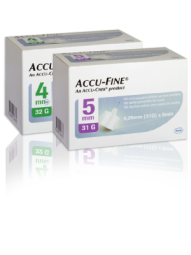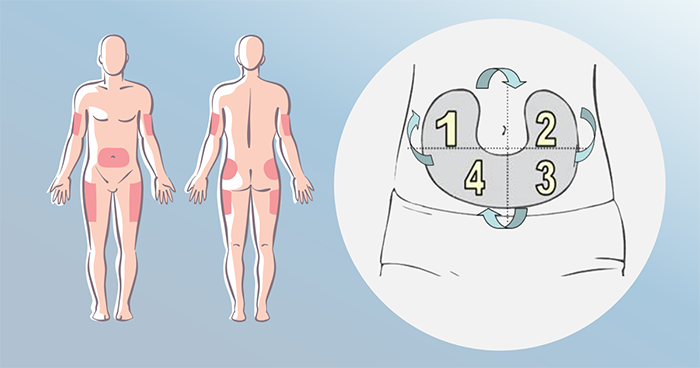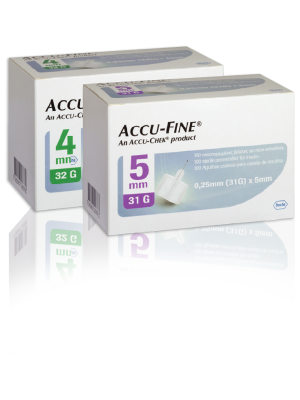
The insulin pen needles from the Accu-Fine product range allow for a gentle1 injection as well as particularly safe & practical handling. Accu-Fine needles can be used with all common insulin pens. The needles are available in lengths of 4, 5, 6, 8, and 12.7 mm, suitable for all1.
- Gentle injection: special cut for gentle insertion under the skin, special coating for gliding into the skin and thin wall for more rapid insulin flow
- Dual protection: with two protective covers.
- Protective cap with dual function
- Sealed sterile protective cap
- Easy screwing and unscrewing of the needle
- Additional Protective cap
- Sterile needle tip ensures safe use
- Protective cap with dual function
- Practically for everyone: regardless of gender, age or BMI
- Compatible: with all common insulin pens
- Minimizes the risk of painful intramuscular injections: with smaller needle lengths
This product is available in selected countries in the Middle East and Africa region. Please visit our Contact Us page to get in touch with your local Roche Diabetes Care entity or Roche Distributor.
0.33mm (29G) x 12.7 mm
0.30mm (30G) x 8 mm
0.25mm (31G) x 8 mm
0.25mm (31G) x 6 mm
0.23mm (32G) x 6 mm
0.25mm (31G) x 5mm
0.23mm (32G) x 4 mm
NovoPen 4, NovoPen 5, NovoPen Echo, NovoPen 3, NovoPen Junior, FlexPen, InnoLet, Victoza Pen
Toujeo SoloStar, TactiPen, ClikSTAR, JuniorStar, SoloStar
KwikPen, HumaPen Savvio, HumaPen Luxura / Luxura HD
BerliPen Areo / Areo3
Byetta 5 mcg, Byetta 10 mcg
Autopen Classic, Autopen 24
Pendiq 2.0
Insulin acts differently, depending on the area injected. The speed at which the insulin reaches the circulation from the different injection areas varies – depending on which area you choose:
- Abdomen: Insulin delivered to the abdomen has the fastest effect on the body.
- Thigh: Delayed onset of action
- Buttocks/Hip: lowest onset of action
The upper layer of the upper arm is thinner, so there is a risk that the injection will be in the muscle. This can be painful and affect the effect of insulin in an unpredictable manner. The 4 mm and 5 mm Accu-Fine needles minimize these risks.
Long-acting insulin injection is recommended to be done in areas where insulin needs more time to develop its activity while fast-acting insulin injection is recommended in areas where insulin needs less time to affect blood glucose.
Very common injections in the same site may cause lipodystrophy (a change in subcutaneous adipose tissue) which may delay the action of insulin. If possible, insulin should not be given more than once in the same cm² within one week. Make sure to change injection sites regularly; Inject insulin into different areas of the body and at different points in one area (clockwise within each area or from area to area).

How to inject
Using Accu-Fine needles does not require pinching of the skin. The needle can be inserted into the skin with one hand at an angle of 90 °. Counting up to 10 during injection minimizes the risk of insulin leakage that could result in an insufficient dose.
Change the needle after each injection
| Using the same needle repeatedly can lower the effect of the injection and lead to infections and lipodystrophy (change of the subcutaneous adipose tissue). For this reason, the needle must absolutely be changed after every use. |  |
Do not inject insulin over clothing
Injection over clothing is unhealthy, if blood or insulin leaks, it will be impossible to identify or clean it. Furthermore, clothes can remove the coating on the needle which allows for easier flow and gentle penetration. With the removal of the coating the needle can also be bent, making the injection more painful.
The correct needle and injection method
Only when using the correct needle and injection method can it be ensured that the insulin is injected into the subcutaneous tissue, and not into the muscle or dermis. The shorter the needle, the lower the risk of adminis-tering the injection into the muscle – which can be painful and also lead to the insulin reaching the blood too fast. Furthermore, the injection is less painful, the thinner the needle is1.
The epidermis and dermis usually do not exceed 3mm1. Below it is the subcutaneous tissue in which insulin injection is to be injected, whereby muscle is under that subcutaneous tissue. Injection into the muscle may be painful and also accelerates the action of insulin.2 A shorter needle, such as the 4 and 5 mm Accu-Fine needles, can reduce this risk but still has a sufficient length to provide insulin to the subcutaneous tissue. Longer needles do not provide any medical benefit, but are associated with a higher risk for painful intramuscular injections1.
What is Gauge and how does it affect injections?
- The Gauge is a unit for the size of the needle diameter.
- The higher the number of gauge, the smaller the needle diameter and the insulin flow. This results in less pain but also more effort required.
- The lower the gauge number, the greater the diameter of the needle and the flow of insulin. This results in more pain but also less effort required.
- The thin needle wall on the Accu-Fine needles allows for a higher insulin flow, even for fine needles with high Gauge.
- Accu-Fine needles combine all the benefits and offer less pain with higher insulin flow and less effort required.
Bibliographic references
1 Gibney MA, et al. Current Medical Research and Opinion 2010; 26: 6, 1519-1530.
2 Thow JC, et al. Diabetes Med1990; 7: 600-602.
3 Aronson R. Diabetes Technol Ther. 2012; 14 (8): 741-747.
4 Süsstrunk et al. Diabetologia 1982; 22 (3): 171-4.
5 Koivisto VA, Felig P. Ann Intern Med. 1980; 92 (1): 59-61.
6 Strauss et al. Practical Diabetes 2002; 19: 3,71-76.

